The Oklahoma History Center: A Museum Completely Captured by Capital and Its Bought Politicians
I care very much about historical memory and the portrayal of the past in history museums. They have such great potential for telling real and interesting stories about the past that inform the present. But they so often far short. There are many reasons for this. First is a lack of funding. Second is that those invested in history museums quite often tend to be white conservatives, the fuddy-duddy types who think Davey Crockett’s gun is the most awesome artifact one could ever present and that it should be presented without any that complex history that might make people think of what Crockett did with that gun. As we’ve seen at Charlottesville and in this ridiculous right-wing freakout over Critical Race Theory, by which they mean “teaching an honest depiction of the nation’s past,” we know that battles over historical memory are very much battles over power in the present. Who gets to tell stories? What perspectives will they highlight? Who decides the content? These are the same battles over who has power in contemporary society. Increasingly, these perspectives are being contested as activists on the left challenge traditional conservative telling of our collective past that highlight rich white men and downplay the racism, genocide, and environmental fallout of what created the contemporary United States.
These issues are all the more challenging at history museums affiliated with the federal government and especially with the states. We saw 25 years ago how an honest telling of the dropping of the atomic bombs on Japan could lead to an enormous right-wing backlash over the Smithsonian, to the point that the presently construed Museum of American History is almost completely worthless. The fear over saying anything controversial, where a Republican congressional aide could come in and shout “CRITICAL RACE THEORY!” because of an exhibit on the legacy of lynching or the rise of climate change or whatever has created a museum where nothing interesting happens at all. People still go of course, but they aren’t learning anything. Notably, this issue works differently at the museums dedicated to people of color. I have not been lucky enough yet to go to the African-American Museum, but at the National Museum of the American Indian, it’s all quite well done, with interesting stories abounding. The reason for this to me is fairly obvious–those are considered spaces to tell those other stories and so the racists just aren’t going to go and complain. It’s not Real American History after all, it’s those people telling their stories. Let me tell my stories under the auspices of Real American History and we will leave you Indians alone to do whatever you want, more or less.
The states are an even more difficult place to tell honest stories about the past. What happens in many state history museums is a version of how corporations like their world regulated: at the state level. Remember, that the business community hates federal regulations because they can’t always control what happens at the EPA or OSHA. Those agencies are too big and might force real changes. The local level is too small and thus given to liberal cities demanding changes the states don’t want. That’s why you see state laws overriding city-wide minimum wage or COVID regulations. The states are where they want it because state politicians can be controlled and that can happen for cheap.
So imagine you are working as an exhibit developer for a state history museum. The stories you can tell are strictly limited by the politics of your state and the politics of your board or other governing structure. You are told to raise money, thus the need for corporate donors. Even in a blue state, the need to satisfy local corporate heads and the moderate Democrats who rely on them can provide a serious restriction on the stories you can tell. Again, even in these states, older whiter and richer people are more likely to care about what’s in the state history museum than outside activists.
This is a long prelude to discuss the incredible badness of the Oklahoma History Center, which is the state history museum in Oklahoma. It’s a prime example of how a very well funded history museum can manage to tell absolutely no stories that even remotely challenge the politics of the people who visit and how they do little more than assuage the egos of the corporate heads and Republican politicians who fund and oversee it.
Before I get into this, there is an exception and that’s the wing of the museum given over to the tribes to tell their story. Even given the terrible politics of Oklahoma, you can’t operate there without giving at least lip service to the tribes and their tremendously complex relationship with the place. So like the American Indian Museum at the Smithsonian, the tribes are allowed to tell their stories the way they want to tell them. It’s very interesting and covers everything from pre-Columbian artifacts to contemporary Indian beauty pageants, of course with a large amount on Indian Removal into modern Oklahoma. This exhibit is a great space to compare the rest of this monstrosity.
Now, onto the rest of it. The centerpiece of the museum, advertised as put together by its executive director, is titled Crossroads of Commerce: A History of Free Enterprise in Oklahoma. It’s an unhinged exercise in corporate propaganda. Nothing if not well-funded, as I am sure the business interests love it, there are videos of Oklahomans introducing various parts of the state’s beloved free enterprise, starting with….Roy Clark, great country guitarist and co-host of the awful Hee-Haw.
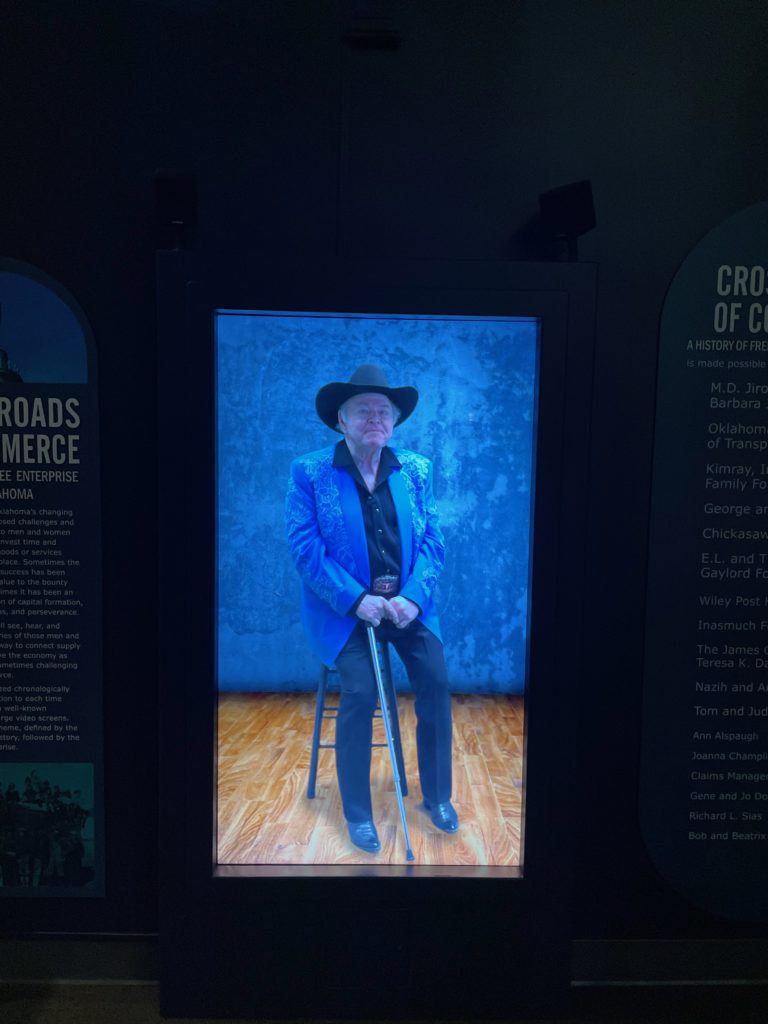
Well, that’s certainly worth a chuckle. But as the exhibit goes on, the attempts to connect everything to “free enterprise” gets kind of ridiculous. For instance, a big piece of it is a replica of a barndance stage that Bob Wills might have played on.

Now, I am certainly not saying that Bob Wills was some sort of commie or anything. In fact, I have no idea what Bob Wills’ politics were. But to make this a centerpiece of something on free enterprise requires one to say that the only reason a music industry exists is because of the greatness of free enterprise capitalism. And while people certainly have profited off of music, there’s a lot of reasons why music exists other than free enterprise. I’d also note that while you might see Roy Clark and you might see Bob Wills, you know who is nowhere to be found here? Yes, that’s right, the one musician most identified with Oklahoma: Woody Guthrie. Gee, I wonder why that is?
Then it just gets more ridiculous. Just withing the realm of music, citing cheap sunglasses endorsed by the Oak Ridge Boys as a sign of the greatness of free enterprise is in fact a great example of the cheapness and awfulness of contemporary consumer capitalism. I mean, really?
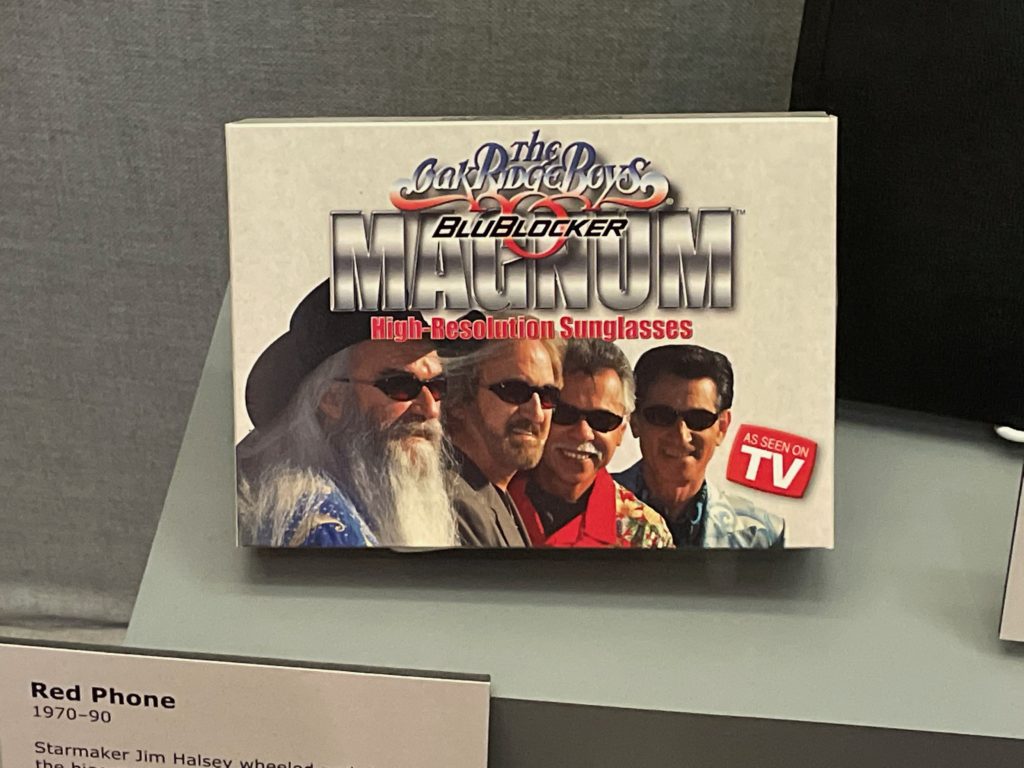
I’m definitely compelled to invest more.
More offensive are the attempts to shoehorn Native history as a celebration of contemporary free enterprise.

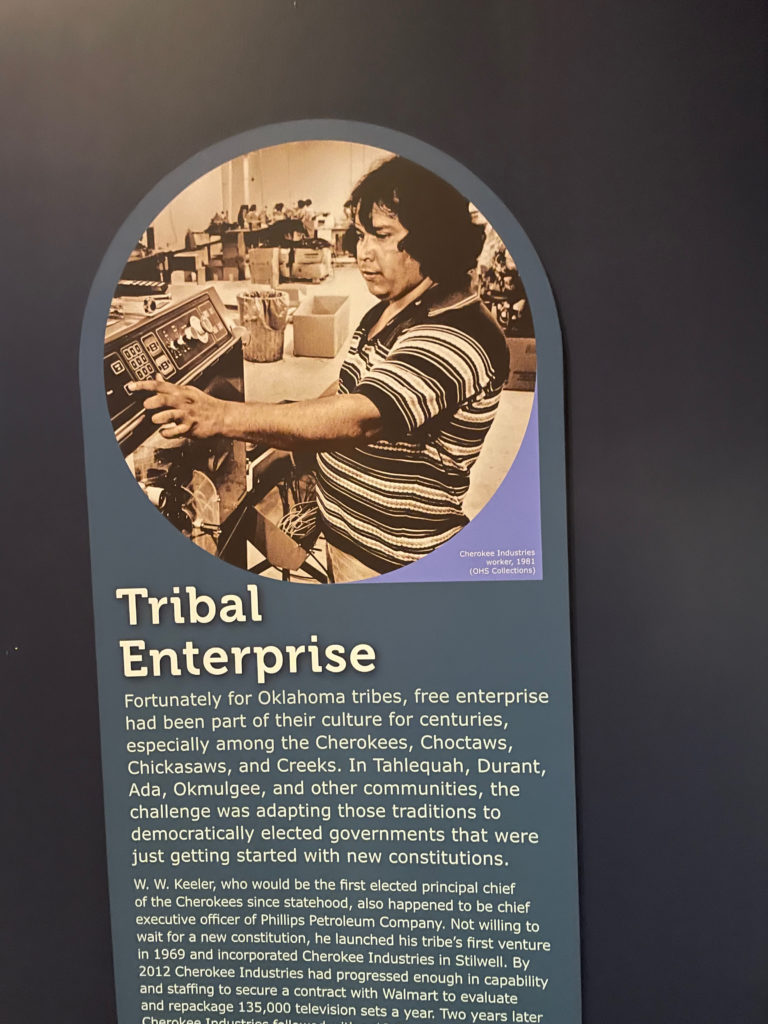
There were earlier panels about how tribal trading networks showed that Oklahoma has always been committed to free enterprise that I didn’t take pictures of, but I wish I had. This is…ridiculous. Obviously, the tribes have to live in the same general economic system as everyone else at this point, but the history of Native peoples in Oklahoma is not one of the glories of free enterprise. In fact, free enterprise, backed by massive government support despite the rhetoric as always, was a big reason for all the genocidal acts that have taken place in Oklahoma. After all, the expansion of whites into Oklahoma was directly connected to capitalism, as a savvy read of this sign suggests.
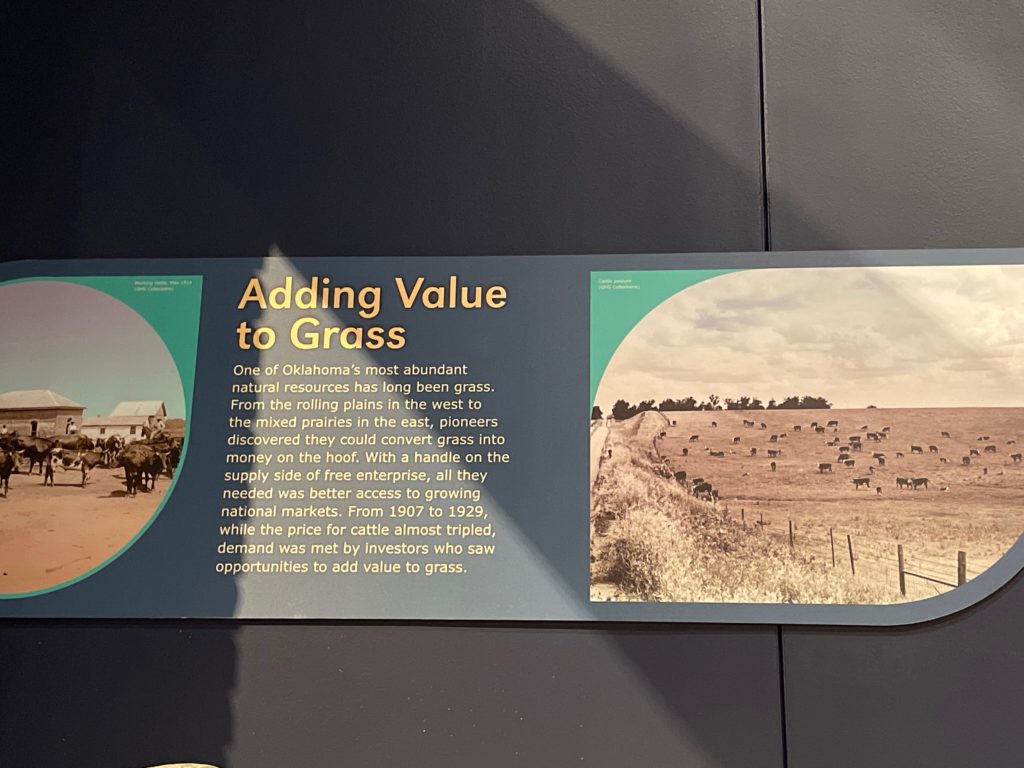
Adding value to grass. I wonder who won and lost in that arrangement?
Then there’s the standard paeans to various Oklahoma-based corporations:

And what has this glorious history of capitalism led to, as the exhibit ends? Yes, that’s right: stealing the Sonics from Seattle.

You finally leave this exhibit and enter the next. You think, well, at least I get to see something different, right? Nope! Instead, it’s another exhibit to the glories of capitalism, this one dedicated just to the energy industry and sponsored by that lovely company, Kerr-McGee. Will you be surprised that Karen Silkwood is not mentioned here? No, I don’t suppose you would.
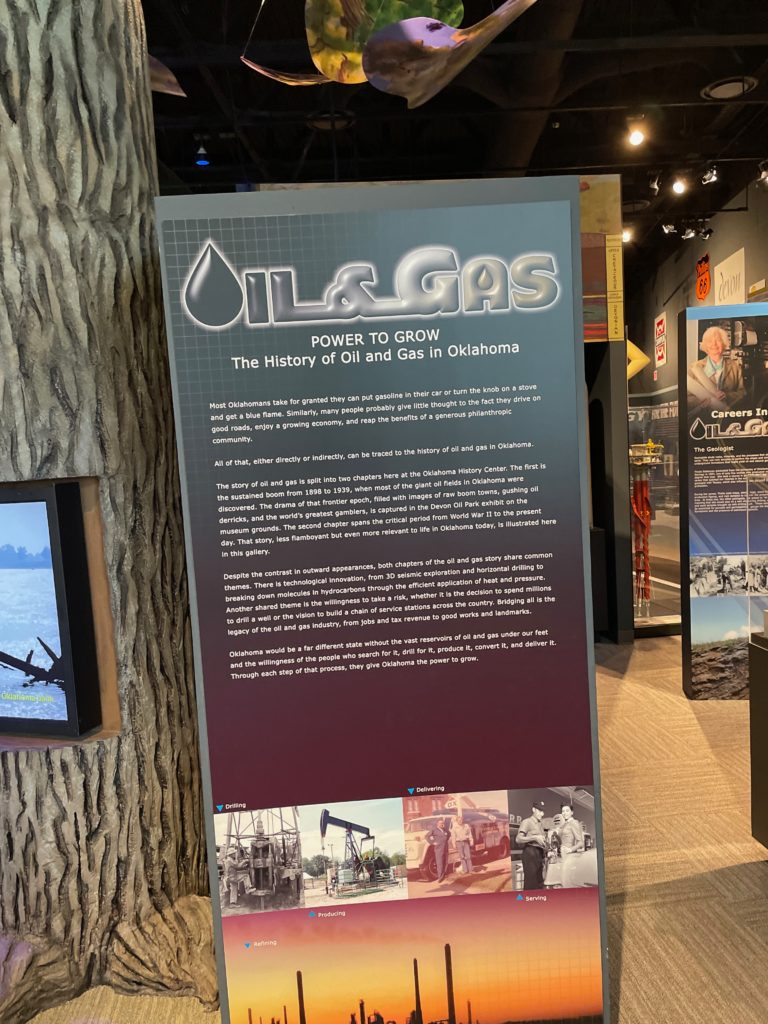
This exhibit is just tremendously boring.
Then there’s a small exhibit room on Oklahoma and outer space, which does have the Skylab 4 Apollo Command Module on display and I have to say that’s pretty cool. So OK.
The final major exhibit space is the catch-all, extending from the land rush of 1889 to various minority groups (this is where you get some wordy and not great exhibits on the Tulsa Massacre of 1921) to a replica of some 19th century riverboat. Included in this is another thing that the donors will love while the ignore the Tulsa stuff: talking about how great the military is. You get to pretend you are in a Vietnam helicopter shooting up Vietnamese civilians:

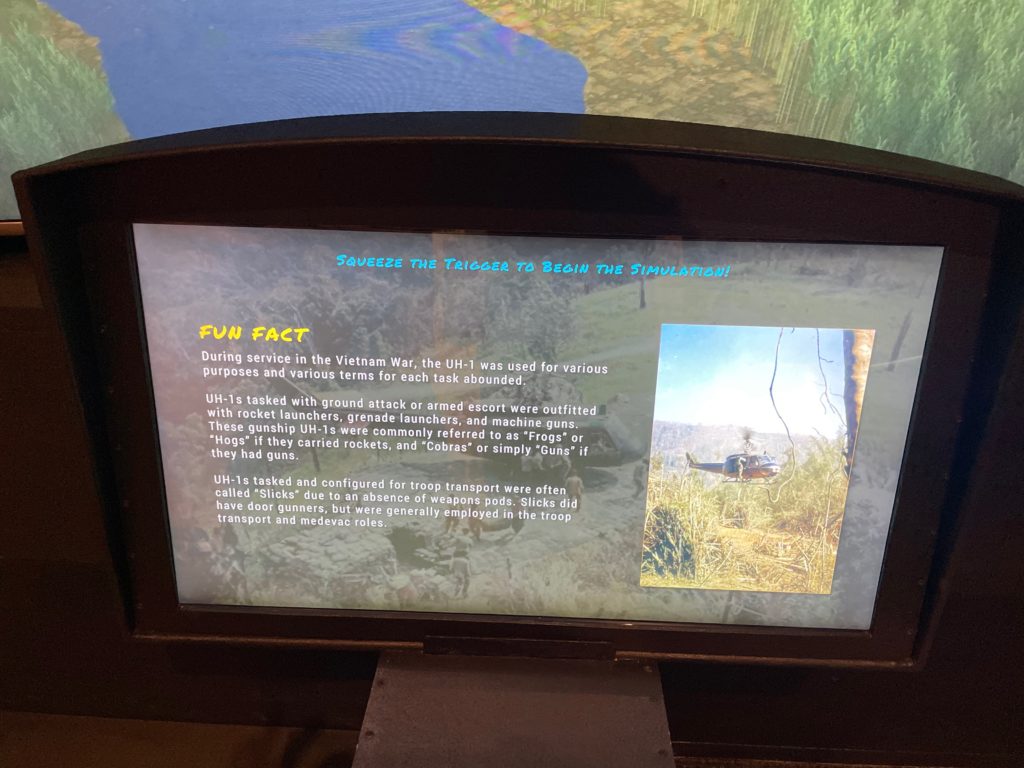
That is a fun fact!
And then you get presented with outright lies about the Vietnam War:

This quote about hippies harassing returning soldiers at the airport and then the soldiers attacking them is pure bullshit. It did not happen. There is no evidence from the time that anything like this ever happened. There is no evidence that antiwar protestors spat on returning soldiers. None. Not one single piece of evidence. And this from a media ready to jump on anything the protestors did to make them look bad. These are lies propagated later by veterans to help make up for their own failings in Vietnam, even if those failings weren’t their fault.
This was the only time at the museum that I was outright angry. It is one thing for a history museum–especially a state-sanctioned one–to tell a corporate-dominated history. It’s another to tell outright lies about the past, just because they serve the interest of right-wing talking points today. This is absolutely outrageous.
But hey, at least when you leave, you can see outside exhibits on….Vietnam helicopters again.


In conclusion, the Oklahoma History Center is a terrible museum. I have little doubt that, especially given the beautiful facility and corporate funding, that they have hired some excellent curators. There was a small but neat photo exhibit on prohibition in Oklahoma, which extended well past 1933. But it really must be a miserable place to work, knowing that you will never, ever be able to say anything that challenges the orthodoxy of the state’s Republican and corporate elites.


